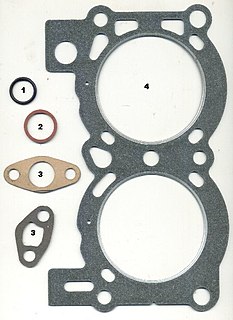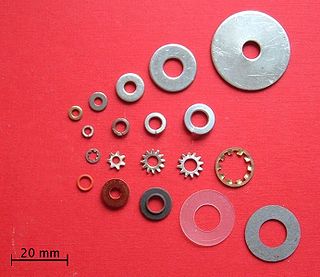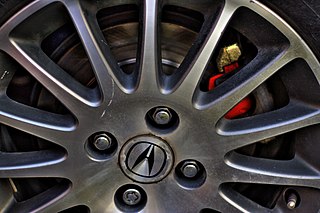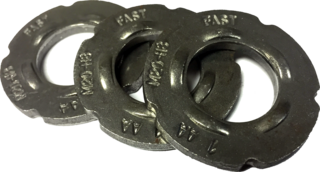
A gasket is a mechanical seal which fills the space between two or more mating surfaces, generally to prevent leakage from or into the joined objects while under compression.

A washer is a thin plate with a hole that is normally used to distribute the load of a threaded fastener, such as a bolt or nut. Other uses are as a spacer, spring, wear pad, preload indicating device, locking device, and to reduce vibration. Washers often have an outer diameter (OD) about twice their inner diameter (ID), but this can vary quite widely.

A clevis fastener is a three-piece fastener system consisting of a clevis, clevis pin, and tang. The clevis is a U-shaped piece that has holes at the end of the prongs to accept the clevis pin. The clevis pin is similar to a bolt, but is only partially threaded or unthreaded with a cross-hole for a split pin. The tang is a piece that fits in the space within the clevis and is held in place by the clevis pin. The combination of a simple clevis fitted with a pin is commonly called a shackle, although a clevis and pin is only one of the many forms a shackle may take.

A socket wrench is a type of wrench or spanner that has a socket attached at one end, usually used to turn a fastener.

Safety wire or locking-wire is a type of positive locking device that prevents fasteners from loosening or falling out due to vibration and other forces. The presence of safety wiring may also serve to indicate that the fasteners have been properly tightened.

A lug nut or wheel nut is a fastener, specifically a nut, used to secure a wheel on a vehicle. Typically, lug nuts are found on automobiles, trucks (lorries), and other large vehicles using rubber tires.

A locknut, also known as a lock nut, locking nut, prevailing torque nut, stiff nut or elastic stop nut, is a nut that resists loosening under vibrations and torque. Elastic stop nuts and prevailing torque nuts are of the particular type where some portion of the nut deforms elastically to provide a locking action. The first type used fiber instead of nylon and was invented in 1931.

Anchor bolts are used to connect structural and non-structural elements to the concrete. The connection is made by an assembling of different components such as: anchor bolts, steel plates, stiffeners. Anchor bolts transfer different types of load: tension forces and shear forces. A connection between structural elements can be represented by steel column attached to reinforced concrete foundation. Whereas, a common case of non-structural element attached to a structural one is represented by the connection between a facade system and a reinforced concrete wall.
Brinelling is the permanent indentation of a hard surface. It is named after the Brinell scale of hardness, in which a small ball is pushed against a hard surface at a preset level of force, and the depth and diameter of the mark indicates the Brinell hardness of the surface. Brinelling is a process of wear in which similar marks are pressed into the surface of a moving part, such as bearings or hydraulic pistons. The brinelling is usually undesirable, as the parts often mate with other parts in very close proximity. The very small indentations can quickly lead to improper operation, like chattering or excess vibration, which in turn can accelerate other forms of wear, such as spalling and galling.
Multi-jackbolt tensioners (MJT) provide an alternative to traditional bolted joints rather than needing to tighten one large bolt, MJTs use several smaller jackbolts to drastically reduce the torque required to attain a certain preload. MJTs range in thread sizes from 3/4” to 32” and can achieve up to 20 million pounds of force and greater. MJTs only require hand-held tools, such as torque wrenches or air/electric impacts, for loading and unloading bolted joints.

A nut is a type of fastener with a threaded hole. Nuts are almost always used in conjunction with a mating bolt to fasten multiple parts together. The two partners are kept together by a combination of their threads' friction, a slight stretching of the bolt, and compression of the parts to be held together.

Thread-locking fluid or threadlocker is a thin, single-component adhesive, applied to the threads of fasteners such as screws and bolts to prevent loosening, leakage, and corrosion.

A bolt is a form of threaded fastener with an external male thread. Bolts are closely related to screws.

Direct tension indicators, or DTIs, are single use mechanical load cells used to indicate when the required tension has been achieved in structural fastener assemblies.
A torque to yield fastener (TTY) or stretch bolt is mounting hardware in the form of a fastener which is torqued beyond the state of elasticity and therefore undergoes plastic deformation, causing it to become permanently elongated.
A Junker test is a mechanical test to determine the point at which a bolted joint loses its preload when subjected to shear loading caused by transverse vibration.

















